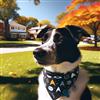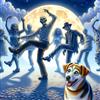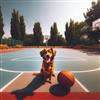1610s Dog Names - Page 4
Updated: July 12, 2024
Welcome to a page that takes a step back in time, specifically to the 17th century. During this era, canine companions were as cherished as they are today, and their names were often reflective of traits, noble figures, and classical mythology. This page offers a distinctive collection of monikers that were popular among dog owners in the 1610s.
Immerse yourself in a time when dogs were named after gods, goddesses, heroes, and heroines from ancient tales. This collection also includes names inspired by nature, popular historical figures, and even daily life objects. While some of these names may seem unusual for today's dog owners, they provide a unique and charming glimpse into the past. Their rich historical significance and often profound meanings make them an intriguing choice for naming your own furry friend.
So, step back into the era of Shakespeare and Rembrandt, a time when the New World was just beginning to be explored. Dive into a wealth of historical dog names that were as interesting and varied as the times themselves. Whether you're a history enthusiast, a lover of unique names, or simply looking for a distinct name for your pup, this collection from the 1610s is sure to inspire.
| Name | Reason to Choose |
|---|---|
| Orson | Unusual names like Orson were also used during this era |
| Orville | This name was used in the 1610s, often associated with French nobility |
| Oscar | A common choice during the 1610s, given its strength and simplicity |
| Oswald | This name of English origin meaning 'divine power', was popular in the 1610s |
| Percival | Frequently used during the 17th century |
| Percy | This name, associated with British nobility, was used in the 1610s |
| Phineas | Frequently used during the 17th century |
| Piers | Even in the 1610s, Piers was chosen for its unique sound |
| Preston | A place name of English origin meaning 'priest's town', used in the 1610s |
| Quentin | A Latin name meaning 'fifth', used in the 1610s, especially for the fifth child |
| Quincy | Its uniqueness made it a common name in the 1610s |
| Quintus | A Latin name meaning 'fifth', used in the 1610s, especially for the fifth child |
| Radcliffe | This English surname, meaning 'red cliff', was used as a first name in the 1610s |
| Randall | This name of English origin meaning 'shield wolf', was popular in the 1610s |
| Reginald | A typical name from the era |
| Reuben | Popular biblical name during the 1610s |
| Roderick | Popular during the 1610s |
| Roger | A frequently chosen name in the 1610s due to its traditional roots |
| Rufus | This name was commonly used due to its strong, unique sound |
| Rupert | A typical name from the era |
| Samuel | Chosen often due to its religious importance |
| Seymour | This name of French origin meaning 'marshy land near the sea', was used in the 1610s |
| Sheridan | This Irish surname, meaning 'wild one', was used as a first name in the 1610s |
| Silas | Biblical names like Silas were popular during the 1610s |
| Simeon | Biblical names like this were frequently chosen |
| Simon | Biblical names like Simon were popular during the 1610s |
| Solomon | A common name from the 17th century |
| Sterling | Frequently used during the 17th century |
| Thaddeus | Popular during the 1610s |
| Theophilus | Frequently used during the 17th century |
|
Suggest:
|
Submitted!
|
| 1 2 3 4 5 | |
Artistic Influences
| Name | Description |
|---|---|
| Berchem | Inspired by Nicolaes Pieterszoon Berchem, a Dutch Golden Age painter |
| Bol | Referring to Ferdinand Bol, a Dutch artist known for his portraits and historical allegories |
| Caravaggio | Paying tribute to Michelangelo Merisi da Caravaggio, a famous Italian painter from the 1600s |
| Carracci | After Annibale Carracci, an Italian painter who played a key role in the development of 17th century Italian art |
| Elsheimer | Named after Adam Elsheimer, a German artist specialized in highly detailed, small-scale paintings |
| Gentileschi | Artistic tribute to Artemisia Gentileschi, a groundbreaking female artist of the Baroque period |
| Guercino | Inspired by Giovanni Francesco Barbieri, known as Guercino, an Italian Baroque painter |
| Hals | A nod to Frans Hals, a Dutch Golden Age portrait painter |
| Jordaens | Named for Jacob Jordaens, a Flemish painter known for his history paintings |
| Leyster | After Judith Leyster, a Dutch Golden Age painter, one of the first known female artists |
| Lorrain | Named after Claude Lorrain, a French painter known for his landscape paintings |
| Maes | Derived from Nicolaes Maes, a Dutch painter known for his domestic genre scenes |
| Murillo | Referring to Bartolomé Esteban Murillo, a Spanish Baroque painter |
| Poussin | After Nicolas Poussin, a French painter in the classical style |
| Rembrandt | Named after Rembrandt Harmenszoon van Rijn, a notable Dutch artist of the 17th century |
| Reni | Named for Guido Reni, an Italian painter known for his religious works |
| Ribera | After Jusepe de Ribera, a Spanish Tenebrist painter and printmaker |
| Rubens | After Peter Paul Rubens, a renowned Flemish artist known for his Baroque style |
| Steen | Named after Jan Steen, a Dutch genre painter of the 17th century |
| Terborch | After Gerard ter Borch, a Dutch genre painter during the Dutch Golden Age |
| VanDyck | Refers to Anthony van Dyck, a Flemish Baroque artist known for his portraits |
| Velázquez | Inspired by Diego Velázquez, an influential Spanish painter of the 17th century |
| Vermeer | Derived from Johannes Vermeer, a Dutch artist known for his detailed domestic interior scenes |
| Vouet | Acknowledges Simon Vouet, a French painter who helped introduce the Italian Baroque style to France |
| Zurbarán | Referring to Francisco Zurbarán, a Spanish painter known for his religious paintings and still lifes |
|
Suggest:
|
Submitted!
|
Astronomical Terms
| Name | Description |
|---|---|
| Andromeda | A northern constellation situated between Cassiopeia and Pegasus |
| Aquila | The name of a constellation in the northern sky |
| Auriga | A constellation in the northern hemisphere, named after the charioteer Auriga |
| Capella | The brightest star in the constellation Auriga |
| Cassiopeia | A northern constellation named after a vain queen Cassiopeia in Greek mythology |
| Comet | A celestial object consisting of a nucleus of ice and dust |
| Cygnus | A constellation lying on the plane of the Milky Way |
| Draco | A constellation in the far northern sky |
| Galileo | Named after Galileo Galilei who was a prominent astronomer in the 1610s |
| Helios | In honor of the Greek god of the sun |
| Hercules | A constellation named after Hercules, the Roman mythological hero adapted from the Greek hero Heracles |
| Hubble | Named after the Hubble telescope, a powerful tool used for astronomical observations |
| Jupiter | Galileo observed this planet's moons in 1610 |
| Kepler | Johannes Kepler, a contemporary of Galileo, made significant contributions to astronomy during this era |
| Nebula | A cloud of gas and dust in outer space |
| Nova | A star showing a sudden large increase in brightness and then slowly returning to its original state over a few months |
| Orion | One of the most conspicuous and recognizable constellations in the night sky |
| Pegasus | A constellation in the northern sky, named after the winged horse Pegasus in Greek mythology |
| Polaris | The North Star, used for navigation for centuries |
| Ptolemy | Claudius Ptolemy was a Greek-Roman citizen of Egypt who wrote in Greek, and was an important astronomer |
| Rigel | The brightest star in the constellation Orion |
| Sirius | It's the brightest star in the Earth's night sky |
| Tycho | Named after Tycho Brahe, the preeminent observational astronomer of the pre-telescopic period |
| Vega | The brightest star in the constellation Lyra, the fifth-brightest star in the night sky |
| Venus | The second planet from the sun, it's the brightest natural object in the night sky after the Moon |
|
Suggest:
|
Submitted!
|
Literature Inspired
| Name | Description |
|---|---|
| Antonio | In 'The Merchant of Venice', Antonio is a merchant and friend to Bassanio |
| Ariel | In 'The Tempest', Ariel is a spirit who serves Prospero |
| Banquo | A character in 'Macbeth', represents loyalty and moral integrity |
| Bassanio | Portia's love interest in 'The Merchant of Venice', represents ambition and desire |
| Beatrice | Inspired by the witty and vibrant character in Shakespeare's 'Much Ado About Nothing' |
| Benedick | Beatrice's love interest in 'Much Ado About Nothing', a playful and clever character |
| Caliban | A unique character from 'The Tempest', represents the wild and untamed |
| Claudio | Hero's love interest in 'Much Ado About Nothing', represents youthful passion |
| Cordelia | King Lear's devoted daughter in Shakespeare's tragic play |
| Cymbeline | Title of a play by Shakespeare, written in 1611, it is a romantic name |
| Desdemona | Othello's ill-fated wife from Shakespeare's tragedy 'Othello' |
| Duncan | The king in 'Macbeth', a symbol of order and rightful rule |
| Goneril | One of King Lear's daughters in Shakespeare's play, for a strong-minded dog |
| Hero | A character from 'Much Ado About Nothing', symbolic of innocence and loyalty |
| Iago | A villainous character in 'Othello', perfect for a mischievous dog |
| Imogen | A character in Shakespeare's 'Cymbeline', she is a symbol of innocence and virtue |
| Jessica | Shylock's daughter in 'The Merchant of Venice', a symbol of love and rebellion |
| Lear | Inspired by the tragic king in Shakespeare's 'King Lear' |
| Macbeth | The name of the tragic hero in Shakespeare's play 'Macbeth' |
| Miranda | From 'The Tempest' by Shakespeare, she is the daughter of Prospero and a symbol of purity |
| Othello | The name of the tragic hero in Shakespeare's play 'Othello' written in 1604 |
| Portia | A clever and virtuous character from Shakespeare's 'The Merchant of Venice' |
| Prospero | Inspired by the character from the Shakespearean play 'The Tempest' written in 1611 |
| Regan | Another of King Lear's daughters, a complex character in Shakespeare's play |
| Shylock | A complex character from 'The Merchant of Venice', a name for a dog with a strong personality |
|
Suggest:
|
Submitted!
|
Geographical Locations
| Name | Description |
|---|---|
| Alexandria | Named after the historic Egyptian city, a center of learning and culture in the 1610s |
| Antwerp | Antwerp, a Belgian city, was a major European trade center in the 1610s |
| Bermuda | This British island colony in the Atlantic was established in the early 1600s |
| Bristol | This English city was a bustling port during the 1610s |
| Cairo | This Egyptian city was a bustling hub of trade and culture during the 1610s |
| Calais | Named after the French port city, which was a significant trade hub during the 1610s |
| Ceylon | Reflects the ancient name for Sri Lanka, a prominent center of spice trade during the 1610s |
| Delhi | Derived from the city in India, which was a significant cultural and economic center in the 1610s |
| Dublin | This Irish city was a significant cultural and political center during the 1610s |
| Havana | Named after the capital city of Cuba, critical to Spain's New World empire in the 1610s |
| Jamestown | The first permanent English settlement in the Americas, established in the early 1600s |
| Java | Java, an Indonesian island, was a critical hub of spice trade in the 1610s |
| Kyoto | The historical city of Japan, which was the country's capital and a center of culture and arts during the 1610s |
| Lisbon | Lisbon is the capital of Portugal, a country that had a global maritime empire in the 1610s |
| London | Named after the capital city of England, which was thriving in the 1610s |
| Macao | This city was a significant Portuguese trading post in China during the 1610s |
| Madagascar | Derived from the island nation discovered by the Europeans in the 1500s and explored throughout the 1610s |
| Manila | This city in the Philippines was a significant Spanish colonial outpost in the 1610s |
| Oslo | Named after the capital city of Norway, a country known for its explorations during the 1610s |
| Plymouth | Named after the English city from where the Mayflower sailed in 1620, marking the end of the 1610s |
| Quebec | The city in Canada was founded in the early 1600s and was a significant colonial settlement |
| Seville | This Spanish city was a critical hub of trade and exploration during the 1610s |
| Sydney | In honor of Sir Philip Sidney, a prominent figure during the Elizabethan era |
| Venice | Reflects the city in Italy famous for its canals and gondolas, which were at their peak in the 1610s |
| Vienna | The historical city of Austria was a significant center of arts and culture during the 1610s |
|
Suggest:
|
Submitted!
|
Historical Figures
| Name | Description |
|---|---|
| Bacon | Francis Bacon, a significant philosopher, was active during this era |
| Caravaggio | Italian painter Caravaggio was prominent in the 1610s |
| Cervantes | A tribute to Miguel de Cervantes, author of Don Quixote |
| Champlain | Samuel de Champlain was a famous explorer during this time |
| Descartes | René Descartes, a notable philosopher and mathematician, was active during this time |
| Galileo | Named after Galileo Galilei, a prominent astronomer during the 1610s |
| Gustavus | Named after Gustavus Adolphus of Sweden, a key figure in the early 17th century |
| Hakluyt | Richard Hakluyt was a notable English writer and geographer |
| Harvey | William Harvey, an English physician, made major contributions to the understanding of blood circulation |
| Hooke | Robert Hooke, a key scientist of the era, was born in the 1630s |
| Hudson | Henry Hudson, famous explorer, was active during the 1610s |
| Kato | After Kato Kiyomasa, a notable Japanese daimyo of the early 17th century |
| Kepler | Named after Johann Kepler, a key astronomer of the era |
| Locke | John Locke, a significant philosopher, was born in the mid-17th century |
| Milton | John Milton, famous poet, was born in the 1610s |
| Pascal | Blaise Pascal, a notable mathematician and philosopher, was born in the 1620s |
| Pocahontas | She was a Native American woman notable for her association with the colonial settlement at Jamestown, Virginia |
| Raleigh | Sir Walter Raleigh, an explorer and poet was a prominent figure |
| Rembrandt | Rembrandt, the Dutch master, began his career in the 1610s |
| Rosetti | Barbara Rosetti was a notable Italian poetess of the early 17th century |
| Rubens | Peter Paul Rubens, a famous painter during the 1610s |
| Shakespeare | William Shakespeare, the English playwright, was active during the early 17th century |
| Tycho | Tycho Brahe, famous Danish astronomer, was active in the early 17th century |
| Velazquez | In honor of Diego Velazquez, a famous painter in the 1610s |
| Vermeer | Johannes Vermeer, a famed artist, was born in the 1610s |
|
Suggest:
|
Submitted!
|
User Submitted Images
There are currently no user submitted images for this page. This is your opportunity to be the first! Submit your photo below.
User Recommendations
There are currently no name recommendations for this page. This is your opportunity to be the first! Make your recommendation below.
Recently Updated
We would like to take this time to thank all of our visitors that make DogNamed.com the best dog naming resource on the web. Our site would not be where it is today without your suggestions, ratings, and photo submissions. So pat yourselves on the back for a job well done and keep up the good work! If you have any comments, suggestions, or ideas for the this page or any part of our site, don't hesitate to drop us a line on our Contact Page. Thank you! -The DogNamed Team




























